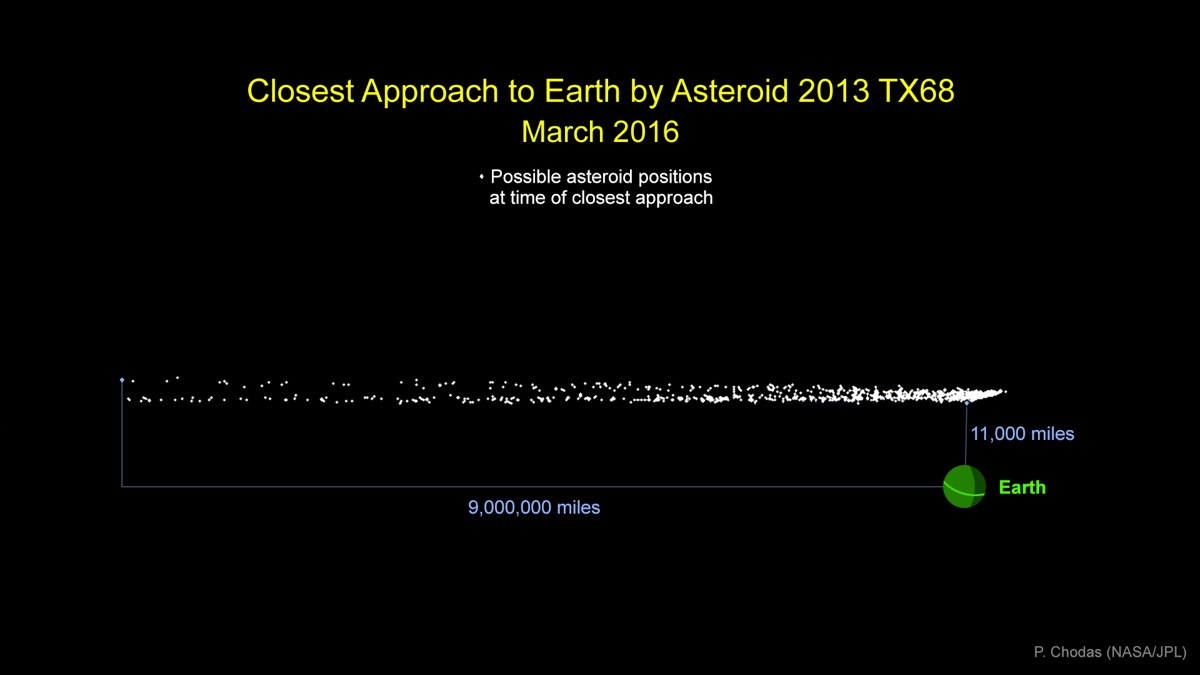
An asteroid as long as a basketball court will give Earth a close shave next month — though scientists aren't sure just how close.
The near-Earth asteroid 2013 TX68, which is thought to be about 100 feet (30 meters) in diameter, will zoom past our planet on March 5. The space rock could come as close as 11,000 miles (17,700 kilometers) — less than 5 percent of the distance from Earth to the moon — or stay up to 9 million miles (14.5 million km) away during the flyby, NASA officials said.
"The variation in possible closest-approach distances is due to the wide range of possible trajectories for this object, since it was tracked for only a short time after discovery," NASA officials wrote in a statement Wednesday (Feb. 3). [Potentially Dangerous Asteroids in Pictures]
There is no danger that 2013 TX68, which was first spotted in October 2013, will collide with Earth on this pass, researchers said. However, there is an extremely slight chance — less than 1 in 250 million — of an impact on Sept. 28, 2017, and even lower odds during flybys in 2046 and 2097.
"The possibilities of collision on any of the three future flyby dates are far too small to be of any real concern," Paul Chodas, manager of the Center for NEO Studies at NASA's Jet Propulsion Laboratory in Pasadena, California, said in the same statement. "I fully expect any future observations to reduce the probability even more."
Just two years ago, 2013 TX68 flew by Earth, at a distance of 1.3 million miles (2 million km).
Scientists think the near-Earth object that exploded over the Russian city of Chelyabinsk in February, damaging buildings and injuring more than 1,000 people, measured about 65 feet (20 m) across. If 2013 TX68 or another asteroid of its size were to slam into Earth, it would probably explode in an airburst about twice as energetic as the Chelyabinsk event, NASA officials said.
Get the Space.com Newsletter
Breaking space news, the latest updates on rocket launches, skywatching events and more!
Follow Mike Wall on Twitter @michaeldwall and Google+. Follow us @Spacedotcom, Facebook or Google+. Originally published on Space.com.
Join our Space Forums to keep talking space on the latest missions, night sky and more! And if you have a news tip, correction or comment, let us know at: community@space.com.

Michael Wall is a Senior Space Writer with Space.com and joined the team in 2010. He primarily covers exoplanets, spaceflight and military space, but has been known to dabble in the space art beat. His book about the search for alien life, "Out There," was published on Nov. 13, 2018. Before becoming a science writer, Michael worked as a herpetologist and wildlife biologist. He has a Ph.D. in evolutionary biology from the University of Sydney, Australia, a bachelor's degree from the University of Arizona, and a graduate certificate in science writing from the University of California, Santa Cruz. To find out what his latest project is, you can follow Michael on Twitter.









